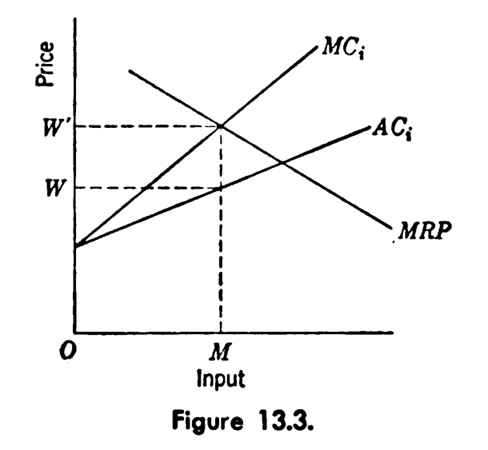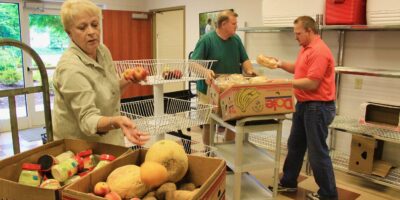Eyes on the Politicized Prize

The selection of economist David Card as co-recipient of the 2021 Nobel memorial prize for Economics has, curiously, revived an old story about a war of words from another laureate. According to this account, James M. Buchanan – the winner of the 1986 prize – allegedly denounced Card for finding empirical results that contradicted basic economic theory about the minimum wage.
We’ll get to that story in a moment, but first let’s look at the background.
David Card’s many scholarly distinctions include a 1994 study of minimum wage policies in the fast food industry. In that study Card and his co-author Alan Krueger used the different minimum wage rates in the neighboring states of New Jersey and Pennsylvania to run what was essentially a natural experiment. They surveyed fast food establishments near the borders of the two states to see if the higher minimum wage rate in New Jersey caused an increase in unemployment among fast food workers (conventional economic theory about price floors says that it should, all else equal). Contrary to this expectation, Card and Krueger “found no indication that the rise in the minimum wage reduced employment” in the New Jersey fast food industry. And so began a legend of a feud.
Card and Krueger’s paper was intentionally narrow and nuanced in its claims. They only studied a single industry, and did so with a telephone survey that collected self-reported data from the restaurants they called. They concluded by noting that their findings were “difficult to explain with the standard competitive model” of the minimum wage “or with models in which employers face supply constraints (e.g., monopsony or equilibrium search models)” – findings that lend themselves to a call for further investigation. Despite Card and Krueger’s heavy use of qualifiers to limit overly broad generalizations of their findings, academics and politicians who already had an ideological disposition toward the minimum wage did exactly that. A myth was soon born that Card and Krueger had “disproven” conventional textbook economic theory where the minimum wage was concerned, showing instead that minimum wages work as their supporters claim.
Fast forward to 1996. President Bill Clinton had just announced a legislative push for a nationwide minimum wage hike as part of his domestic agenda going into an election year. As Congress debated the proposal, the Wall Street Journal surveyed a group of economists about the profession’s consensus on the wisdom or unwisdom of minimum wage laws.
One of the respondents was James M. Buchanan. Buchanan answered with a colorful quip:
The inverse relationship between quantity demanded and price is the core proposition in economic science, which embodies the presupposition that human choice behavior is sufficiently rational to allow predictions to be made. Just as no physicist would claim that “water runs uphill,” no self-respecting economist would claim that increases in the minimum wage increase employment. Such a claim, if seriously advanced, becomes equivalent to a denial that there is even minimal scientific content in economics, and that, in consequence, economists can do nothing but write as advocates for ideological interests. Fortunately, only a handful of economists are willing to throw over the teaching of two centuries; we have not yet become a bevy of camp-following whores.
And so the story was born. Had Buchanan actually called Card and Krueger “a bevy of camp-following whores” on account of his disagreement with their natural experiment’s findings?
The claim has popped up from time to time before, but the announcement of Card’s prize breathed new life into it. Bloomberg’s Noah Smith used the opportunity to declare that “James Buchanan — who himself won the Econ Nobel in 1986 — simply laughed at the result,” allegedly insulting Card and Krueger in the process. “Of course, Buchanan is completely wrong,” he continued, invoking the monopsony model of the minimum wage – which holds that under certain highly specific conditions of labor market concentration, a minimum wage can indeed lead to an increase in employment.
Smith is not the only one to make this charge against Buchanan – he is merely the most recent. Angus Deaton, another Nobel Prize winner, included it in his book The Great Escape, noting that Card and Krueger’s “heresy created heated denunciations” from “enraged economists.” Buchanan’s quip is then put forward by Deaton as Exhibit A in the persecution of their “heresy.”
Had Smith, Deaton and numerous others who repeated the tale caught Buchanan in an act of exchanging grade school insults over a disliked empirical result? Or worse, of trying to denigrate and suppress a scientific finding that was supposedly at odds with a long-held economic dogma?
Not so fast. Let’s return to the Wall Street Journal issue on April 24, 1996, where Buchanan’s answer appeared. Contrary to the insinuation by Smith and others, the Journal’s question for the economist was actually not about the already two year old study by Card and Krueger – it was about Bill Clinton’s proposed minimum wage bill. The newspaper’s prompt read simply:
Congress will soon vote on whether to increase the minimum wage to $5.15 an hour from $4.25 an hour. As usual, the economic arguments for and against a raise in the minimum wage have been obscured by rhetoric. While some economists have become caught up in the rhetorical excess preceding the vote, this does not obscure the real economic effects of raising the minimum wage. We asked a group of prestigious economists what those effects were, and whether there is still a general consensus among economists on this issue.
While Card and Krueger’s study was certainly a hot topic of discussion within the profession (and remains so today with large literatures that both claim to confirm and refute its findings), it was not what the Journal asked its respondents to comment upon. To the extent that Card and Krueger’s paper entered into the equation, it was through the political lens of the Clinton administration’s legislative agenda.
Clinton’s then-Labor Secretary Robert B. Reich had taken to arguing that the unemployment effects of a nationwide minimum wage hike would be “negligible” and “statistically insignificant.” To make his case, Reich cherry-picked several recent pro-minimum wage studies from the academic literature that fit the political story he wished to tell. The first of these was not Card and Krueger, but rather another study by Allison J. Wellington that claimed a 10 percent minimum wage hike reduced teenage employment by less than 1 percent. Reich also referenced similar claims by Jacob Klerman, and finally Card and Krueger. Unfortunately, Krueger himself got drawn into the political debate for a time by Reich, who convinced him to take on an advisory role with the Labor Department in 1995. For the most part and to his credit, Krueger constrained his political testimony to the narrow, heavily caveated findings of his study of the New Jersey restaurant industry. Reich, on the other hand, invoked it and the other aforementioned studies as unambiguous vindications of the sweeping nationwide minimum wage hike that the Clinton administration sought.
Summarizing his argument in congressional testimony from 1995, Reich asserted that “of the articles published in peer-reviewed American economics journals over the past five years, a majority has found that moderate changes in the minimum wage have an insignificant effect on employment.” The accuracy of Reich’s claim is both contested and beyond our present scope, although if true it would belie the notion that Card and Krueger had single-handedly bucked the profession. Yet it also establishes the many ways in which the political system had coopted academic research on the minimum wage, and was now deploying it to aggressively argue for policy conclusions that exceeded the narrow scholarly claims of that same body of research.
Although it’s possible or even likely he contemplated Card and Krueger’s study among the arguments he was opposing, Buchanan never even mentioned it or any of the other academic studies by name. Neither did he refer to its main finding of no disemployment effects in the New Jersey restaurants. Rather, he attacked the much bolder general claim that “increases in the minimum wage increase employment” and did so in reference to the nationwide hike contemplated by Clinton’s proposal. (Card and Krueger did find that New Jersey’s minimum wage law “may have increased employment in the fast-food industry” relative to Pennsylvania, but they also cautioned against reaching a general conclusion to this effect and concede that the evidence is only weakly suggestive of this finding).
In any case, Buchanan was clearly responding to a question about Bill Clinton’s 1996 minimum wage hike proposal, not Card and Krueger or any other specific academic paper for that matter. As to the question of who exactly Buchanan meant to target with his comments, he gives the answer one sentence prior. It is those who “write as advocates for ideological interests” when advancing the minimum wage. In short, he was describing the type of behavior exhibited in Robert B. Reich’s recent testimony and public statements.
There’s another twist though. After mistaking the nature of Buchanan’s remarks and omitting the context of the 1996 Clinton proposal, Smith then proceeds to accuse Buchanan of an error in his economic theory. Recall that Card and Krueger concluded their paper by noting that their “findings are difficult to explain with the standard competitive model or with models in which employers face supply constraints (e.g., monopsony or equilibrium search models)” (emphasis added). The two authors did suggest the monopsony scenario as a possible explanation for their findings that warranted investigation, but they carefully avoided making that claim outright.
Smith and others who have commented on Buchanan’s 1996 quip, however, appear to believe that Card and Krueger’s paper sustains the monopsony explanation, thereby indicating that Buchanan was in error in addition to being rude.
Smith thus continues:
Of course, Buchanan is completely wrong. It’s very easy to imagine a situation where a small rise in the minimum wage will increase employment — all you need is some monopsony power in the economy. The basic theory of monopsony, which ought to be taught in every Econ 101 class right alongside the perfectly competitive model… It’s textbook stuff — or should be textbook stuff, anyway.
Smith, of course, is eager to credit Card and Krueger for bringing the monopsony scenario to the attention of the profession, and even sings their heroics for allegedly challenging a deeply-held convention of the profession. As of 1994, he claims, “Card and Krueger’s finding seemed revolutionary and heretical. In fact, other researchers had probably been finding the same thing, but were afraid to publish their results, simply because of their terror of offending the orthodoxy.” In that telling, Buchanan thus assumes the role of Grand Inquisitor against the minimum wage-supporting heretics.
Unknown to him and other commentators in the same vein, however, is that Buchanan himself also wrote on the monopsony scenario and its effects on a minimum wage. He wrote a detailed explanation of it some 40 years prior to Card and Krueger and did so in an undergraduate textbook on price theory, co-authored with Clark Allen and Marshall Colberg. As Buchanan and his colleagues wrote in their 1954 textbook Prices, Income, and Public Policy:
The adverse effects of minimum-wage legislation have been stressed so far, and these probably outweigh the beneficial results. On the other side, minimum-wage legislation undoubtedly prevents some employers from paying workers less than their marginal revenue product. This is especially apt to happen when workers do not “shop around” enough to be aware of alternative employment opportunities or if these alternatives are few or nonexistent. This is the monopsony case, discussed in Chapter 13. Under this sort of situation it is possible that the imposition of a minimum wage will make the firm hire more rather than fewer workers. For this effect to follow, however, the legal minimum wage would have to be placed between the wage rate actually being paid by the firm and the marginal revenue product of the labor employed (between OW and OW’ in Figure 13.3). This gap will vary from firm to firm. This makes it extremely unlikely that the imposition of a uniform legal minimum wage (affecting all firms) has the overall effect of increasing rather than decreasing employment. The minimum wage affects only relatively unskilled labor which usually has a more substantial number of employment alternatives than does higher-paid, but also more highly specialized, labor. Unskilled workers, on the other hand, are often more ignorant of alternative employment opportunities.
The referenced Figure 13.3 in Buchanan’s textbook is the very same diagram of the monopsony model that Smith then repeats in his own article as an example of Buchanan’s supposed oversight.

Indeed, Buchanan’s 1954 account of the monopsony scenario is precisely the type of “textbook stuff” that Smith unwittingly calls for in the wake of Card and Krueger’s paper. The only difference is that Buchanan, while acknowledging the possibility of the monopsony scenario, continues by listing reasons why these conditions are unlikely to be common in practice. The monopsony scenario of the minimum wage was a “theoretical curiosum,” to quote Milton Friedman (who also covered the same scenario in his own 1976 textbook, decades before Card and Krueger). Smith, of course, differs from this assessment and suggests a minimum wage is indeed rendered viable by widespread monopsonistic labor markets. But such a claim also far exceeds Card and Krueger’s own presentation of their results.
Nevertheless, we may conclusively establish that the monopsony scenario of the minimum wage was directly anticipated and discussed by economists for decades before Card and Krueger’s paper. That scenario is also clearly present in the very same types of economics textbooks that, according to the myth promoted by Smith and others, allegedly neglected this nuanced view of the minimum wage.
And it now appears that the author of one of those textbooks, James M. Buchanan, had the last laugh after all.










